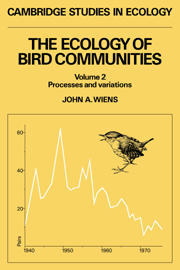5 - Spatial patchiness and scale
Published online by Cambridge University Press: 18 December 2009
Summary
Viewed at any scale of resolution, from an individual's territory to a biogeographic region or a continent, environments are mosaics of patches. Individuals and populations repond to this spatial heterogeneity in various ways, some spending long periods of time within specific patches, some using certain patches for feeding and others for reproduction, still others moving over a mosaic in an apparently aimless fashion but distinguishing between different mosaics. Because the patch structure of an environment changes through time, the responses of individuals and populations to spatial patchiness are dynamic. The structure and dynamics of communities, in turn, are strongly influenced by this spatial variation.
Kareiva (1986) observed that ecologists have had difficulty making sense of insect communities because environmental heterogeneity has generally not been included in theories of species interactions and because spatial dimensions of variation have usually been ignored in field studies. The same could be said of many investigations of bird communities. Much of the theory that has guided community studies has, for simplicity, assumed nature to be spatially homogeneous. Often these theories fail to generate realistic predictions when spatial patchiness is introduced (Schluter 1981, Tilman 1982, Chesson 1986). Likewise, field studies have often been restricted to small sites selected on the basis of their apparent internal homogeneity. In recent years, however, efforts to incorporate the influences of heterogeneity into population or community models have increased (e.g. Roff 1974, Okubo 1980, Paine and Levin 1981, Nisbet and Gurney 1982, Chesson 1981, 1985, 1986, Levin et al. 1984), and the importance of ‘patch dynamics’ has become more widely appreciated in field studies (Pickett and White 1985).
- Type
- Chapter
- Information
- The Ecology of Bird Communities , pp. 200 - 248Publisher: Cambridge University PressPrint publication year: 1989



